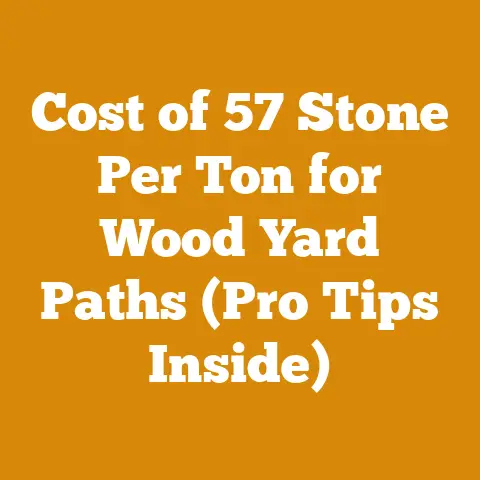Crimp Stove Pipe Solutions (Wood Stove Fitting Tips for Loggers)
Alright folks, gather ’round the virtual wood stove! Ever feel like wrestling an octopus when trying to connect your wood stove pipe? Like you’re all thumbs and the metal’s got a personal vendetta against you? I’ve been there. More times than I care to admit. I’ve even had a stove pipe collapse on me mid-winter once, showering me in soot and sending my family into fits of laughter (after they confirmed I was okay, of course!). Getting that stove pipe just right is crucial, not just for warmth, but for safety too. So, let’s dive into the nitty-gritty of crimping stove pipe, the logger’s way, with fitting tips that’ll keep your home cozy and your carbon monoxide detector silent.
The State of Wood Heating: A Global Perspective
Before we get our hands dirty, let’s take a look at the big picture. Globally, wood heating remains a significant energy source, especially in rural areas and colder climates. According to the World Bioenergy Association, wood fuels account for approximately 9% of global primary energy consumption. In many developing countries, it’s the primary source of heat for cooking and warmth. Even in developed nations, the resurgence of wood stoves as a supplemental or primary heating source is driven by factors like rising energy costs and a desire for energy independence.
The North American wood heating market, for example, is projected to reach over $3 billion by 2027, fueled by demand for efficient, EPA-certified wood stoves. This growth highlights the continued relevance of proper stove pipe installation and maintenance. Ensuring optimal draft and preventing dangerous creosote buildup are paramount for both efficiency and safety, making the techniques we’ll cover essential for anyone relying on wood heat.
Understanding the Basics: What is a Stove Pipe and Why Crimp It?
A stove pipe, in the simplest terms, is the duct that carries smoke and combustion gases from your wood stove to the chimney. It’s typically made of single-wall or double-wall steel, with the latter offering better insulation and reduced creosote formation. Crimping is the process of slightly reducing the diameter of one end of the pipe to allow it to fit snugly inside another, creating a secure and leak-proof connection.
Why is crimping so important? Here’s the lowdown:
- Smoke-Tight Seal: Crimping ensures a tight fit, preventing smoke and dangerous gases from escaping into your home. Carbon monoxide poisoning is a real threat with improperly installed stove pipes, so this is non-negotiable.
- Proper Draft: A well-sealed stove pipe creates a consistent draft, allowing your stove to burn efficiently and cleanly. A poor draft leads to smoky fires, increased creosote buildup, and wasted fuel.
- Structural Integrity: Crimped joints provide added stability to the stove pipe system, reducing the risk of collapse or separation.
My Wood-Fired Journey: Lessons Learned the Hard Way
I wasn’t always a stove pipe whisperer. My first attempt at installing a wood stove was a comedy of errors. I bought a used stove from a neighbor, thinking I was saving a bundle. I skipped reading the instructions (a cardinal sin, I know!), and just started piecing the stove pipe together. The result? A leaky, smoky mess that set off my smoke alarm more times than I care to remember.
That experience taught me a valuable lesson: proper planning and execution are crucial. I ended up replacing the entire stove pipe system and taking the time to learn the right techniques. Now, I approach every stove pipe installation with the meticulousness of a seasoned logger planning a timber harvest.
Tools of the Trade: Essential Gear for Crimping Stove Pipe
Before you start bending metal, you’ll need the right tools. Here’s a list of essentials:
- Stove Pipe Crimper: This is the star of the show. A good crimper creates uniform, consistent crimps without damaging the pipe. I recommend investing in a quality tool that will last for years. My personal favorite is the Malco C5 crimper.
- Gloves: Always wear heavy-duty work gloves to protect your hands from sharp edges. Leather gloves are ideal.
- Safety Glasses: Metal shavings and dust can be a real hazard. Protect your eyes with safety glasses.
- Measuring Tape: Accurate measurements are critical for a proper fit. Use a quality measuring tape that’s easy to read.
- Marker or Pencil: Use a marker or pencil to mark cutting lines and reference points.
- Tin Snips or Aviation Snips: For cutting stove pipe to length. Aviation snips offer more leverage and are easier to use for thicker materials.
- File or Deburring Tool: To smooth out sharp edges after cutting.
- Level: To ensure the stove pipe is vertical and plumb.
- Stove Pipe Thermometer: To monitor the stove pipe temperature and prevent overheating.
- Carbon Monoxide Detector: A must-have for any home with a wood stove.
Data Point: A study by the National Fire Protection Association (NFPA) found that improper installation or maintenance of heating equipment, including wood stoves, is a leading cause of residential fires. Investing in the right tools and following proper installation procedures can significantly reduce your risk.
Step-by-Step Guide: How to Crimp Stove Pipe Like a Pro
Now, let’s get down to business. Here’s a detailed, step-by-step guide on how to crimp stove pipe:
- Measure and Cut: Measure the length of stove pipe you need and mark the cutting line with a marker. Use tin snips or aviation snips to cut the pipe to length. Be sure to cut straight and clean.
- Deburr the Cut Edge: Use a file or deburring tool to smooth out any sharp edges on the cut end of the pipe. This will prevent cuts and make it easier to insert the crimped end into another section of pipe.
- Position the Crimper: Open the jaws of the stove pipe crimper and position the tool around the end of the pipe you want to crimp. Ensure the crimper is aligned perpendicular to the pipe.
- Crimp the Pipe: Squeeze the handles of the crimper firmly to create a crimp. Rotate the crimper slightly and repeat the process to create another crimp. Continue rotating and crimping until you have a series of evenly spaced crimps around the circumference of the pipe.
- Check the Fit: Test the fit of the crimped end into another section of stove pipe. It should slide in easily but snugly. If it’s too tight, add a few more crimps. If it’s too loose, you may need to start over with a new section of pipe.
- Assemble the Stove Pipe System: Once you’ve crimped all the necessary sections of stove pipe, begin assembling the system. Start at the stove and work your way up to the chimney. Overlap each section of pipe by at least 2 inches.
- Secure the Joints: Use stove pipe screws to secure each joint. Drill pilot holes before inserting the screws to prevent the pipe from splitting. Space the screws evenly around the circumference of the pipe.
- Inspect for Leaks: After the stove pipe system is assembled, inspect all the joints for leaks. Use a smoke pencil or incense stick to check for drafts. If you find any leaks, seal them with high-temperature silicone sealant.
- Test the Draft: Light a small fire in the stove and observe the draft. The smoke should be drawn up the chimney quickly and efficiently. If the draft is poor, check for obstructions in the stove pipe or chimney.
- Monitor the Temperature: Use a stove pipe thermometer to monitor the temperature of the stove pipe. Keep the temperature within the manufacturer’s recommended range to prevent overheating and creosote buildup.
Unique Insights: The Logger’s Advantage
Being a logger gives you a unique perspective on wood processing and firewood preparation. We understand the importance of precision, efficiency, and safety. Here are a few insights that can help you with your stove pipe installation:
- Wood Species Matters: The type of wood you burn affects the amount of creosote produced. Softwoods like pine and fir tend to produce more creosote than hardwoods like oak and maple. Season your firewood properly to reduce moisture content and minimize creosote buildup.
- Draft is King: A strong draft is essential for efficient combustion and reduced creosote formation. Ensure your chimney is properly sized and maintained. Consider installing a chimney cap to prevent rain and debris from entering the chimney.
- Regular Inspections are Key: Inspect your stove pipe system regularly for signs of damage or creosote buildup. Clean the stove pipe and chimney at least once a year, or more often if you burn a lot of wood.
Case Study: Reviving an Old Farmhouse with Efficient Wood Heat
I once helped a friend restore an old farmhouse that hadn’t been heated in years. The existing chimney was in poor condition, and the stove pipe system was a disaster. We replaced the chimney liner, installed a new EPA-certified wood stove, and carefully assembled the stove pipe system using the techniques I’ve described.
The result was a warm, cozy home that was significantly more energy-efficient than the old electric heaters. My friend was thrilled with the savings on his heating bill, and I was proud to have helped him bring new life to his historic farmhouse.
Data Point: EPA-certified wood stoves are significantly more efficient and cleaner-burning than older models. They can reduce particulate emissions by up to 70% and improve fuel efficiency by up to 50%.
Troubleshooting: Common Pitfalls and How to Avoid Them
Even with the best preparation, things can sometimes go wrong. Here are a few common pitfalls to avoid:
- Incorrect Pipe Diameter: Make sure you’re using the correct diameter stove pipe for your stove. Using the wrong size can lead to poor draft and dangerous gas leaks.
- Over-Crimping: Crimping the pipe too much can weaken the metal and make it difficult to insert into another section. Use a light touch and add crimps gradually until you achieve the desired fit.
- Loose Joints: Loose joints are a major fire hazard. Secure all joints with stove pipe screws and seal any leaks with high-temperature silicone sealant.
- Neglecting Maintenance: Neglecting regular maintenance is a recipe for disaster. Clean your stove pipe and chimney regularly to prevent creosote buildup and ensure proper draft.
Costs and Budgeting: Keeping Your Project on Track
Installing a stove pipe system can be a significant investment. Here’s a breakdown of typical costs:
- Stove Pipe: \$20-\$50 per section
- Stove Pipe Crimper: \$50-\$150
- Tin Snips: \$20-\$50
- Stove Pipe Thermometer: \$20-\$50
- Carbon Monoxide Detector: \$20-\$50
- Professional Installation (if needed): \$200-\$500
To keep your project on track, create a detailed budget before you start. Shop around for the best prices on materials and tools. Consider renting tools if you only need them for a one-time project.
Actionable Tips and Best Practices: Elevating Your Wood Heating Game
Here are a few actionable tips and best practices to help you succeed with your stove pipe installation:
- Read the Instructions: Always read the manufacturer’s instructions for your stove and stove pipe system.
- Plan Your Layout: Plan the layout of your stove pipe system carefully to minimize the number of bends and horizontal runs.
- Use Double-Wall Stove Pipe: Consider using double-wall stove pipe for better insulation and reduced creosote formation.
- Install a Chimney Cap: Install a chimney cap to prevent rain and debris from entering the chimney.
- Season Your Firewood: Season your firewood properly to reduce moisture content and minimize creosote buildup.
- Burn Cleanly: Burn your stove efficiently to reduce smoke and creosote production.
- Get a Professional Inspection: If you’re not comfortable installing the stove pipe system yourself, hire a qualified professional.
Real Examples: Firewood Stacking for Optimal Drying
Proper firewood stacking is crucial for efficient drying. Here are a few stacking techniques to consider:
- Criss-Cross Stacking: This method involves alternating layers of wood in a criss-cross pattern to create air gaps.
- Holz Hausen: This German-style stack is circular and self-supporting, allowing for excellent air circulation.
- Simple Row Stacking: This is the easiest method, but it’s less efficient for drying.
No matter which method you choose, be sure to stack your firewood in a sunny, well-ventilated location. Cover the top of the stack with a tarp to protect it from rain and snow.
Data Point: Properly seasoned firewood has a moisture content of 20% or less. Burning seasoned wood can increase your stove’s efficiency by up to 30% and reduce creosote buildup significantly.
Next Steps and Additional Resources: Continuing Your Wood Heating Education
Congratulations! You’ve taken the first step towards mastering the art of crimping stove pipe. Here are a few next steps to continue your wood heating education:
- Research Local Regulations: Check your local building codes and regulations regarding wood stove installation.
- Attend a Workshop: Consider attending a workshop on wood stove installation and maintenance.
- Join a Wood Heating Forum: Join an online forum to connect with other wood heating enthusiasts and ask questions.
- Consult with a Professional: If you have any questions or concerns, consult with a qualified wood stove professional.
Here are a few additional resources to help you on your journey:
- National Fire Protection Association (NFPA): www.nfpa.org
- Environmental Protection Agency (EPA): www.epa.gov
- Wood Heat Organization: www.woodheat.org
Suppliers of Logging Tools and Drying Equipment:
- Northern Tool + Equipment: Wide range of logging tools, chainsaws, and wood splitters.
- Bailey’s: Specializes in logging and forestry equipment.
- Arborist Supply: Offers a variety of tree care and logging tools.
- Local Rental Services: Check local rental services for wood splitters, moisture meters, and other equipment.
Remember, wood heating is a rewarding and sustainable way to keep your home warm. By following these tips and techniques, you can ensure a safe, efficient, and enjoyable wood heating experience. Now go forth and conquer that stove pipe! Just remember, measure twice, crimp once!






